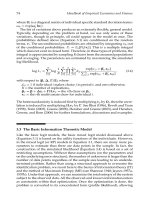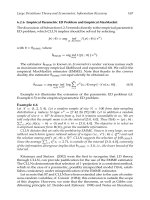International handbook of development economics
Bạn đang xem bản rút gọn của tài liệu. Xem và tải ngay bản đầy đủ của tài liệu tại đây (4.5 MB, 1,178 trang )
INTERNATIONAL HANDBOOK
OF DEVELOPMENT ECONOMICS
VOLUME ONE
International Handbook
of Development Economics
Volume One
Edited by
Amitava Krishna Dutt
University of Notre Dame, USA
and
Jaime Ros
University of Notre Dame, USA
Edward Elgar
Cheltenham, UK • Northampton, MA, USA
© Amitava Krishna Dutt and Jaime Ros 2008
All rights reserved. No part of this publication may be reproduced, stored in a
retrieval system or transmitted in any form or by any means, electronic, mechanical or photocopying, recording, or otherwise without the prior permission of the
publisher.
Published by
Edward Elgar Publishing Limited
The Lypiatts
15 Lansdown Road
Cheltenham
Glos GL50 2JA
UK
Edward Elgar Publishing, Inc.
William Pratt House
9 Dewey Court
Northampton
Massachusetts 01060
USA
A catalogue record for this book
is available from the British Library
Library of Congress Control Number: 2008927966
ISBN 978 1 84542 327 8 (2 volume set)
Printed and bound in Great Britain by MPG Books Ltd, Bodmin, Cornwall
Contents
viii
xiii
List of contributors
Preface
PART I
1
2
3
4
5
6
INTRODUCTION
The meaning and measurement of development
Paul Streeten
Historical perspectives on development
Amiya Kumar Bagchi
Empirics of growth and development
Steven N. Durlauf, Andros Kourtellos and Chih Ming Tan
Structural change and development
Moshe Syrquin
Interdisciplinary approaches to development: the ‘institutional’
turn
Peter Evans
Data problems and empirical modeling in developing economies
Bill Gibson
3
16
32
48
68
83
PART II ALTERNATIVE APPROACHES TO
DEVELOPMENT
7
8
9
10
11
12
13
Historical antecedents of development economics
Gianni Vaggi
Classical development theory
Jaime Ros
Theories of dependency
José Gabriel Palma
Structuralism
José Gabriel Palma
Marxism and development
Bob Sutcliffe
Institutionalist development economics
Kenneth P. Jameson
Neoclassical development economics
Salim Rashid
v
97
111
125
136
144
162
176
vi
International handbook of development economics, 1
PART III
14
15
16
17
18
General long-run approaches to growth and development
Amitava Krishna Dutt
New growth theory and development economics
Heinz D. Kurz and Neri Salvadori
Short-run macroeconomic issues in development
Peter J. Montiel
Sectoral interactions in development
Jørn Rattsø
Open-economy issues in development
José Antonio Ocampo
PART IV
19
20
21
22
23
24
25
26
27
28
29
MACROECONOMICS OF GROWTH
AND DEVELOPMENT
189
207
223
238
252
FACTORS IN DEVELOPMENT
Savings, investment and capital accumulation
Andrés Solimano and Mario Gutierrez
Role of finance and credit in economic development
Philip Arestis and Santonu Basu
Physical infrastructure
Gregory K. Ingram and Marianne Fay
Population and development
Dennis Ahlburg and Robert Cassen
Labor markets in developing countries
Albert Berry
Education and human capital
George Psacharopoulos and Harry Anthony Patrinos
Health and nutrition and economic development
Harold Alderman, Jere R. Behrman and John Hoddinott
Entrepreneurship and development
E. Wayne Nafziger
Natural resources and development
Richard Auty
The environment and development
John McPeak
Technical choice and technological change in development
Howard Pack
269
290
301
316
328
341
356
371
388
404
417
Contents
PART V
30
31
32
33
34
35
SECTORS IN DEVELOPMENT
Factor market imperfections in poor agrarian economies
Parikshit Ghosh and Ashok Kotwal
The Green Revolution
Robert E. Evenson
Industry and industrial policy
Helen Shapiro
The informal sector
Victor E. Tokman
Services and development
Dilip Dutta
Urbanization and rural–urban migration
Charles M. Becker
Index
vii
435
453
470
483
497
516
533
Contributors
Ahlburg, Dennis: Leeds School of Business, University of Colorado,
Boulder, Colorado, USA
Alderman, Harold: World Bank, Washington, DC, USA
Arestis, Philip: Department of Land Economy, University of Cambridge,
Cambridge, UK
Auty, Richard: Department of
Lancaster, UK
Geography, Lancaster University,
Bagchi, Amiya Kumar: Institute of Development Studies, Kolkata, India
Baland, Jean-Marie: Centre for Research in the Economics of
Development (CRED), University of Namur, Namur, Belgium
Balasubramanyam, V.N.: Department of Economics, Lancaster University,
Lancaster, UK
Bardhan, Pranab: Department of Economics, University of California,
Berkeley, California, USA
Basu, Santonu: Queen Mary, University of London, London, UK
Becker, Charles M.: Department of Economics, Duke University, Durham,
North Carolina, USA
Behrman, Jere R.: Department of Economics, University of Pennsylvania,
Philadelphia, Pennsylvania, USA
Berry, Albert: Department of Economics, University of Toronto, Toronto,
Canada
Birdsall, Nancy: Center for Global Development, Washington, DC, USA
Brown, Graham: Department of International Development, University of
Oxford, Oxford, UK
Bruton, Henry J.: Department of Economics, Williams College,
Williamstown, Massachusetts, USA
Cassen, Robert: London School of Economics, London, UK
Dahi, Omar S.: School of Social Science, Hampshire College, Amherst,
Massachusetts, USA
viii
Contributors
ix
Damon, Amy: University of Minnesota, Minneapolis-St. Paul, Minnesota,
USA
Darity, William A., Jr: Duke University, Durham, North Carolina, USA
Demir, Firat: Department of Economics, University of Oklahoma,
Norman, Oklahoma, USA
Durlauf, Steven N.: Department of Economics, University of WisconsinMadison, Madison, Wisconsin, USA
Dutt, Amitava Krishna: Department of Economics and Policy Studies,
University of Notre Dame, Notre Dame, Indiana, USA
Dutta, Dilip: Faculty of Economics and Business, University of Sydney,
Sydney, Australia
Elson, Diane: Levy Economics Institute of Bard College, and Department
of Sociology, University of Essex, Colchester UK
Evans, Peter: Department of Political Science, University of California,
Berkeley, California, USA
Evenson, Robert E.: Department of Economics, Yale University, New
Haven, Connecticut, USA
Fay, Marianne: World Bank, Washington, DC, USA
Fishlow, Albert: School of International and Public Affairs, Columbia
University, New York, USA
FitzGerald, Valpy: University of Oxford, Oxford, UK
Ghosh, Jayati: Centre for Economic Studies and Planning, School of Social
Sciences, Jawaharlal Nehru University, New Delhi, India
Ghosh, Parikshit: Indian Statistical Institute, Delhi, India
Gibson, Bill: Department of Economics, University of Vermont,
Burlington, Vermont, USA
Glass, Amy Jocelyn: Department of Economics, Texas A&M University,
College Station, Texas, USA
Glewwe, Paul: Department of Applied Economics, University of
Minnesota, St Paul, Minnesota, USA
Gray, Cheryl W.: World Bank, Washington, DC, USA
Griffith-Jones, Stephany: Institute of Development Studies, University of
Sussex, Brighton, UK
x
International handbook of development economics, 1
Gutierrez, Mario: International consultant, Paris, France
Hoddinott, John: International
Washington, DC, USA
Food
Policy
Research
Institute,
Hoksbergen, Roland: Department of Economics, Calvin College, Grand
Rapids, Michigan, USA
Huang, Yasheng: Sloan School of Management, Massachusetts Institute of
Technology, Cambridge, Massachusetts, USA
Ingram, Gregory K.: Lincoln Institute of Land Policy, Cambridge,
Massachusetts, USA
Jager, Henk: Amsterdam School of Economics, University of Amsterdam,
Amsterdam, The Netherlands
Jameson, Kenneth P: Department of Economics, University of Utah, Salt
Lake City, Utah, USA
Jha, Raghbendra: Division of Economics, Australian National University,
Canberra, Australia
Jomo K.S.: Department of Economic and Social Affairs, United Nations,
New York, USA
Kaminsky, Graciela L.: George Washington University and NBER,
Washington, DC, USA
Knaack, Ruud: Amsterdam School of Economics, University of
Amsterdam, Amsterdam, The Netherlands
Kotwal, Ashok: Department of Economics, University of British
Columbia, Vancouver, Canada
Kourtellos, Andros: Department of Economics, University of Cyprus,
Nicosia, Cyprus
Kozul-Wright, Richard: Department of Economic and Social Affairs,
United Nations, New York, USA
Kurz, Heinz D.: Department of Economics, University of Graz, Graz,
Austria
Masson, Paul R.: Rotman School of Management, University of Toronto,
Toronto, Canada
McPeak, John: Department of Public Administration, Maxwell School,
Syracuse University, New York, USA
Montiel, Peter J.: Williams College, Williamstown, Massachusetts, USA
Contributors
xi
Morley, Samuel A.: International Food Policy Research Institute,
Washington, DC, USA
Nafziger, E. Wayne: Department of Economics, Kansas State University,
Manhattan, Kansas, USA
Ndulu, Benno J.: Governor, Bank of Tanzania, Dar-es-Salaam, Tanzania.
Ocampo, José Antonio: School of International and Public Affairs,
Columbia University, New York, USA
O’Connell, Stephen A.: Department of Economics, Swarthmore College,
Swarthmore, Pennsylvania, USA
Pack, Howard: Department of Business and Public Policy, Wharton
School, University of Pennsylvania, USA
Palma, José Gabriel: University of Cambridge, Cambridge, UK
Patnaik, Prabhat: Centre for Economic Studies and Planning, School of
Social Sciences, Jawaharlal Nehru University, New Delhi, India
Patrinos, Harry Anthony: World Bank, Washington, DC, USA
Platteau, Jean-Philippe: Centre for Research in the Economics of
Development (CRED), University of Namur, Namur, Belgium
Psacharopoulos, George: University of Illinois, Champaign, Illinois, USA
Putterman, Louis: Department of Economics, Brown University,
Providence, Rhode Island, USA
Radelet, Steven: Center for Global Development, Washington, DC, USA
Raffer, Kunibert: Department of Economics, University of Vienna, Vienna,
Austria
Rashid, Salim: Department of Economics, University of Illinois, UrbanaChampaign, Illinois, USA
Rattsø, Jørn: Department of Economics, Norwegian University of Science
and Technology (NTNU), Trondheim, Norway
Rayment, Paul: formerly, Economic Commission for Europe, United
Nations, Geneva, Switzerland
Rivera-Batiz, Francisco L.: Columbia University, New York, USA
Rodríguez, Francisco: Department of Economics, Weslyan University,
Middletown, Connecticut, USA
xii
International handbook of development economics, 1
Ros, Jaime: Department of Economics and Policy Studies and Kellogg
Institute of International Studies, University of Notre Dame, Notre Dame,
Indiana, USA
Saggi, Kamal: Department of Economics, Southern Methodist University,
Dallas, Texas, USA
Salvadori, Neri: Department of Economic Science, University of Pisa, Pisa,
Italy
Sapsford, David: Department of Applied Economics, University of
Liverpool, Liverpool, UK
Sen, Anindya: Indian Institute of Management, Kolkata, India
Shapiro, Helen: Department of Sociology, University of California, Santa
Cruz, CA, USA
Solimano, Andrés: UN-Economic Commission for Latin America and the
Caribbean
Squire, Lyn: Global Development Network, New Delhi, India
Stewart, Frances: Department of International Development, University
of Oxford, Oxford, UK
Streeten, Paul: Emeritus Professor, Department of Economics, Boston
University, Boston, Massachusetts, USA
Sutcliffe, Bob: formerly at University of the Basque Country, Bilbao, Spain
Syrquin, Moshe: School of International Studies, University of Miami,
Coral Gables, Florida, USA
Tan, Chih Ming: Department of Economics, Tufts University,
Medford/Somerville, Massachusetts, USA
Tokman, Victor E.: Economic Advisor to the President of Chile, Santiago,
Chile, formerly at the International Labour Organization, Geneva,
Switzerland
Triplett, Russell E.: University of North Carolina at Chapel Hill, North
Carolina, USA
Vaggi, Gianni: Department of Economics, University of Pavia, Pavia, Italy
Wilber, Charles K.: Professor Emeritus, University of Notre Dame, Notre
Dame, Indiana, USA
Preface
Development economics is a very large and growing subdiscipline or field of
economics. Since it is concerned with the economic problems of economies
which have been variously defined as underdeveloped, less-developed or
developing, and where most of the poor and the underprivileged people of
the world live, it is also arguably one of the most important – if not the most
important – field of economics. It is also a complex field which has been
approached by scholars using different approaches, involving different
definitions of development, different methods of analysis, different views of
how economies function, and different recipes of what should be done to
bring about development. In the course of the evolution of the field, even if
one focuses only on its evolution since the end of World War II, some
approaches have enjoyed greater popularity at certain times, when others
have lost ground, with role reversals later on.
The field’s size, complexity and transformations make it a difficult business to represent it with a handbook, especially when some excellent ones
already exist. But these same features of the field provided us with some
reasons to take on the task. It has been some years since some of the earlier
handbooks were published. To the extent that handbooks survey recent literatures, they become outdated. Moreover, it can be argued that some of
the earlier efforts did not sufficiently take into account the great diversity
of approaches in the field and arguably stressed some approaches more
popular at the time.
In line with our goals, we approached scholars who were experts in their
area to participate in this project. We asked them to discuss what they
believed to be some of the key issues concerning their topic, and of the
major contributions to it, rather than writing exhaustive surveys.
Moreover, we asked the contributors to examine analytical contributions,
as well as the relation between these contributions and real-world and
policy issues, although inviting them to choose the precise balance between
these. We also asked contributors to attempt to cover contributions from
alternative theoretical perspectives. To further have different views represented, especially views under-represented in mainstream development economics, we approached scholars using a variety of different approaches and
devoted an entire section of the Handbook (Part II) to the discussion of
alternative approaches.
The Handbook is divided into nine parts. Part I, which is introductory, discusses the meaning and measurement of economic development, historical
xiii
xiv
International handbook of development economics, 1
and interdisciplinary perspectives on development, empirical regularities in
development, and data problems and empirical modeling in developing
economies.
Part II, as mentioned earlier, deals with alternative approaches. It starts
with earlier contributions to development economics, then discusses classical development theory of the early days after World War II, and then turns
to different approaches to development economics, that is, the dependency
and structuralist approaches, the Marxist approach, the institutionalist
approach and the neoclassical approach. The different approaches can be
characterized in different ways, and our contributors have chosen their own
characterizations.
Part III examines the macroeconomics of growth and development. It
starts with a discussion of general long-run approaches to growth from a
theoretical perspective, and then discusses new growth theory in more
detail. Then it turns to short-run macroeconomic issues. Next it turns to
sectoral interactions, focusing on the interaction between agriculture and
industry, and to general open economic issues in development.
Part IV discusses factors in development, not only in the narrow sense of
inputs such as capital, labor and natural resources, but also in the broader
sense which includes entrepreneurship, the environment and technological
change. On capital, one entry examines savings, investment and capital
accumulation in general, another entry focuses on finance and credit, and
yet another discusses physical infrastructure. On labor, there are entries on
population, labor markets, education and human capital formation, and
health and nutrition. Next it turns to the role of entrepreneurship, and
natural resources are then discussed. The environment is addressed next,
not just as a factor of production, but also in terms of its sustainability. A
final entry addresses technological issues, focusing on technical choice and
technological change.
Part V examines specific sectors in development. On agriculture, there
are entries on agricultural factor markets and institutions and on the socalled Green Revolution, which addresses the issue of technological change
in the sector. Next, the discussion turns to the industrial sector, the informal sector, and services. Finally, there is an entry on urbanization and intersectoral migration.
Part VI turns to international issues. On international trade, it starts with
a discussion of how free trade affects developing countries, then examines
the role of the terms of trade, which has received much attention in the development literature, and then turns to trade policy, especially to the debate
between import-substitution and export-promotion policies. On international capital flows, it examines direct foreign investment, debt and portfolio
flows and addresses the issue of the volatility of capital flows, and then turns
Preface
xv
to foreign aid. Next, international migration and the brain drain are examined. International technology transfers are addressed by focusing on one of
the major modes of such transfers, foreign direct investment. The role played
by international institutions in development is addressed by examining the
Bretton Woods institutions and the World Trade Organization. This part
ends with an examination of the relation between rich and poor countries,
or what is usually referred to as North–South issues.
Part VII examines distributional issues. It first discusses the measurement and determination of income inequality, addressing how development affects inequality. It then turns to how income distribution affects
growth and development. The measurement and determinants of poverty
are addressed in the next entry, examining poverty in a narrow way as well
as a broader, multidimensional way. Issues concerning gender are examined
in the next entry which considers how the fruits of development are shared
between the sexes and whether improving gender distribution and development are positively related. The economic conditions of children and the
impact of growth of children’s welfare are examined next. Finally, this part
examines the measurement and conceptual issues relating to ethnic
inequality, and discusses the relation between ethnic inequality and economic growth.
Part VIII examines the role of the state and other institutions in development. It commences with a general discussion of the two main institutions emphasized in economics, the state and the market. It next examines
different aspects of government policy, that is, monetary policy, fiscal
policy, stabilization policy and structural adjustment, planning and project
appraisal, and state-owned enterprises and privatization. This is followed
by a discussion of corruption. The role of law and legal institutions is
examined next, followed by a discussion of the institution of property
rights. Broader issues regarding culture and development are considered
next. The part concludes with a discussion of the causes and consequences
of wars, especially civil wars, in less-developed countries.
Finally, Part IX provides a review of the main issues concerning recent
actual development experience. It opens with an overall discussion of
development in less-developed regions from an international perspective. It
then examines in turn Latin America and the Caribbean, sub-Saharan
Africa, North Africa and the Middle East, China, South Asia, the East
Asian newly industrialized countries, and the post-socialist transitional
economies. The inclusion of the final region is explained both because these
are often considered to be less-developed countries, and because their experience has important lessons for development.
The chapters just described, numbering 71, have been written by 90 contributors, who live in (or are from) all five continents. This – in addition to
xvi
International handbook of development economics, 1
the fact that it covers development issues relating to, and the experience of,
countries all around the less-developed world – makes the Handbook truly
international in scope.
A work such as this could not have been completed without the hard
work of a large number of people. As editors, we would like to thank all the
contributors, who have graciously devoted time and contributed their
expertise to this project. We would also like thank some other individuals
for their comments and/or suggestions, including Chris Barrett, Kaushik
Basu, Jagdish Bhagwati and Michael Ellerman. A few people whose work
was to be included here – Sanjaya Lall, David Pierce and Richard Sabot –
have passed away. We are grateful for their willingness to contribute and
deeply saddened by their deaths.
The Editors
PART I
INTRODUCTION
1
The meaning and measurement of
development
Paul Streeten
What do people want?
The great West Indian economist and Nobel Prize winner Arthur Lewis
defined development as the enlargement of the range of people’s choices.
Following him the United Nations Development Programme’s Human
Development Reports chose the same definition. Some earlier definitions
have run in terms of commodity bundles or specific needs satisfactions. In
the book First Things First (Streeten et al., 1981) my co-authors and I say:
First, and most important, the basic needs concept is a reminder that the objective of the development effort is to provide all human beings with the opportunity for a full life. In the past two decades, those concerned with development
have sometimes got lost in the intricacies of means . . . and lost sight of the end.
They came near to being guilty, to borrow a term from Marx, of ‘commodity
fetishism’.
‘Opportunity’ is near in meaning to Amartya Sen’s ‘functioning’ and ‘capability’. In our basic needs work we tried hard to get away from the
definition of development in terms of an aggregate of goods and services
produced and consumed and its growth, of the detached objects people
happen to possess, and to emphasize the end: people’s full lives.1
Amartya Sen’s analysis has been in term of ‘capabilities’ and ‘functionings’, and not satisfactions, or happiness, or commodities.2 Sen goes
beyond the analysis of the commodities in terms of their characteristics (a shirt serves warmth and decoration, and if drip-dry saves ironing)
which consumers value, and analyses the characteristics of the consumers;
whether they have the capability to make use of the commodities. The same
amount of food has a different significance: according to whether the consumer is healthy or has parasites in their stomach, in which case the basic
needs of the worms rather than of the consumer are met; according to the
rate of metabolism, the age, sex, size and work load of the consumer;
according to the climate, according to whether she is pregnant or lactating;
according to whether the consumer has acquired through education the
knowledge of how to prepare the food; and according to whether they need
the food for other uses than their own consumption, such as entertainment
or ceremonies.
3
4
International handbook of development economics, 1
Sen also argues that human development cannot be judged only by endstates, and that the freedom to choose between different options is an
important component of well-being. A given commodity bundle has a
different significance to the consumer according to whether he or she has
other options, though he or she does not exercise them, or whether that
same bundle is the only one available. There is a difference between a starving pauper, a fasting monk and Gandhi on hunger strike, which is not
reflected in the low calorie intake of all three. Only the starving pauper
lacks capability. But Sen’s capabilities cannot be observed, while achievements can. If failure of achievement is voluntary, it is acceptable. But some
authors (like Frances Stewart)3 have argued that it is better to separate
freedom of choice and look at poverty in terms of observable achievements.
In this sense, all three are deprived. Sen lumps together achievement and
freedom of choice in happiness ‘capability’.
Happiness, as experienced by the individual, is not what human development can aim at or is mainly about. Not only can the government not
deliver happiness;4 people may be miserably poor and yet be contented.
Anita Brookner in one of her novels tells of a woman who was so modest
that she did not even presume to be unhappy.5 And Susan Minot (1992) in
her novel Folly writes: ‘not only did she not think of making certain choices
herself, she was completely unaware of having the desire to do so’. Indian
women report being ill much less frequently than Indian men.6
The use of Sen’s capabilities can be frustrated if the opportunities for
their exercise do not exist or if individuals are deprived of these opportunities as a result of discrimination, obstacles or inhibitions: if there is no
demand for their productive contributions so that people are unemployed,
or if there are legal or social or conventional restrictions on their employment, or if they do not have enough leisure, or if political oppression or
deprivation of human rights prevents them from full participation in the
life of their communities. There can be ‘jobless’ growth, there can be ‘voiceless’ growth, there can be ‘rootless’ growth, and there can be jobless, voiceless and rootless non-growth. Different countries illustrate each of these
cases.
Getting income is one of the options people would like to exercise. It is
an important, but not an all-important option. Human development
includes the expansion of income and wealth, but it includes many other
valued and valuable things as well.
For example, in investigating the priorities of poor people, one discovers
that what matters most to them often differs from what outsiders assume.
More income is only one of the things desired by poor people. Adequate
nutrition, safe water at hand, better medical services, more and better
schooling for their children, cheap transport, adequate shelter, continuing
The meaning and measurement of development
5
employment and secure livelihoods, and productive, remunerative, satisfying jobs do not show up in higher income per head, at least not for some
time.
There are other non-material benefits that are often more highly valued
by poor people than material improvements. Some of these partake in the
characteristics of rights, both positive and negative; others in those of
states of mind. Among these are good and safe working conditions,
freedom to choose jobs and livelihoods, freedom of movement and speech,
self-determination and self-respect, independence, mobility, liberation
from oppression, violence and exploitation, less dependence on patrons,
security from persecution and arbitrary arrest, not having to move in search
of work, a satisfying family life, the assertion of cultural and religious
values, a sense of identity, access to power or direct empowerment, recognition, status, adequate leisure time and satisfying forms of its use, a sense
of purpose in life and work, the opportunity to join and participate actively
in the activities of civil society, and a sense of belonging to a community.
These are often more highly valued than income, both in their own right
and as means to satisfying and productive work. They do not show up in
higher income figures. No policy-maker can guarantee the achievement of
all, or even the majority, of these aspirations, but policies can create the
opportunities for their fulfillment.
Economic growth can be quite rapid without an improvement in the
quality of life of the majority of the people, and many countries have
achieved a high quality of life with only moderate growth rates of income.
It has been observed that there is a positive correlation between income per
head and the indicators of human development. Some have drawn the erroneous conclusion that it is only income that matters. But, first, this relationship is far from perfect, and the interesting questions are raised by the
outliers and particularly by countries that have achieved high human development at low levels of income. Second, this relation depends entirely on
the extra income that arises from growth being used for public education
and health and for specific attacks on poverty. If these two conditions are
absent, the correlation disappears.7 Much also depends on the initial distribution of assets. If land ownership is fairly equally distributed and mass
education is widespread, the benefits of economic growth will be reflected
in good human development.
Economic growth is often considered to be an essential component of
human development. But growth (in the narrow sense of a continuing
increase of the quantity of goods and services produced and consumed
over time) is simply the inter-temporal dimension of any policy objective,
although it has been wrongly monopolized by production and consumption: it should apply to poverty reduction, employment, investment, a
6
International handbook of development economics, 1
more equitable income distribution, environmental protection, leisure
and, of course, also to income. But once you specify for income, consumption and production, the ‘What?’ ‘To whom?’ ‘By whom?’ ‘For what?’
and ‘When?’ growth becomes the incidental result, not the objective, of a
sensible economic policy. Growth is too unspecified, abstract, aggregate
and unbounded to be a sensible objective of policy. It also implies an
infinite horizon, without limits to increases in income. What matters is the
composition of the national income, to what uses it is put, its distribution
among beneficiaries, now and for future generations; and with how much
effort and in what conditions it is produced. If and only if the extra
resources resulting from growth go largely to the poor, and if they are
spent on public health and education, will a contribution to human development result.
The national income is a quite inadequate measure of human development for several reasons. It counts only goods and services that are
exchanged for money, leaving out of account the large amount of work
done inside the family, mainly by women, and work done voluntarily for
children or older people or in communities. Public services are counted at
their cost, so that doubling the wages of all public servants appears to
double their contribution to welfare or development. National income
accounting does not distinguish between goods and regrettable necessities,
like military or anti-crime expenditure, products needed to combat ‘bads’.
Addictive eating and drinking is counted twice: when the food and the
alcohol are consumed, and when large sums are spent on the diet industry
and on cures for alcoholism. Much of what is now counted as economic
growth is really either combating evils, and fixing blunders and social decay
from the past, or borrowing resources from the future, or shifting functions
from the community and household to the market.8
National income accounting does not add leisure gained by fewer
working hours or an earlier retirement age, and does not subtract from the
extra income-generated leisure lost if women are forced (or desire) to take
on jobs outside the family, or men to take on a second job. Environmental
degradation, pollution and resource depletion are not deducted, so that the
earth is treated, it has been said, like a business in liquidation. Freedom,
human rights and participation are ignored. Most important, the conventional measure does not allow for the distribution of the income, counting
all goods and services at their market prices. Increasing the production of
whiskey, bought by rich men, counts for much more than increasing the
production of milk that would have gone to a starving child. Attempts have
been made here and there to correct for these faults and omissions, but
national income remains a quite inadequate measure of economic welfare
or of development.
The meaning and measurement of development
7
Some of these shortcomings can be removed by adjustments in the
accounting methods. These concern those components of well-being that
can be, in principle, brought into relation with the measuring rod of money.
A monetary value can be attached to leisure time. Income distribution can
be allowed for by attaching greater weights to the incomes and their growth
of the bottom 20 percent, 30 percent or 40 percent of the population.
Depletion of non-renewable raw materials can be evaluated and a measure
for sustainable income can be designed.
For other components of choice and welfare, monetary measurement is
much more difficult or may be impossible. The enjoyment we derive from
an unspoiled wilderness, the satisfaction from work, political engagement
that results from participation, the sense of community, brotherhood and
sisterhood that grows out of social activities, the freedom, peace and sense
of security that are common in a well-run society, these cannot easily be
reduced to dollars and cents. Yet they form the essence of human development.
Human development: the latest stage
The contributing tributaries to human development can be grouped under
five headings: (1) economic growth; (2) human resource development;
(3) human rights and participation; (4) peace and security; and (5) sustainability. The role of culture falls under the heading of human rights and participation. Issues of equity, and in particular of gender equity, run through
all five tributaries.
We now live in a ‘risk society’. People are bombarded with assessments
of the risks of decisions (from what they eat to whether they should build
nuclear power stations). They have lost the old certainties about how their
lives will turn out: no more jobs, or marriages, for life.
Human development is the end, the tributaries are the means; but they can
also acquire end characteristics themselves. Environmental sustainability,
peace, participation, human resources and, by some, even economic growth
are valued in their own right. To the extent that they are ends, they all have
to be included in human development. The five tributaries can augment each
other, for example when human resources contribute to higher growth, or
when respect for human rights advances peace. There are also feedbacks
from achievements in human development to further improvements in
human development. These may be indirect by improving the five components (economic growth, human resource development, human rights and
participation, peace and security, and sustainability), or they may be direct.
The latter occur within and between families when knowledge is passed on
and when better education of mothers has an impact on their children.
Several studies have shown that women’s education, control over cash
8
International handbook of development economics, 1
income and access to power, in addition to being desirable in themselves,
improve the health, nutrition and education of children, reduce fertility,
reduce infant mortality, reduce health hazards of adults arising from low
birth weight, raise productivity, reduce inequality, are beneficial for the environment, and increase the range and effectiveness of public debates.
Gender issues are particularly important for reproductive freedom – for
people, especially women, to be able to choose the size of their families.
There is now a wealth of evidence to show that given the opportunity to
choose smaller families without adverse economic and social consequences,
smaller families are indeed chosen. With human development – that is with
the expansion of education, especially of girls and women, the reduction of
infant mortality rates, and medical facilities (including the opportunity of
birth control) – fertility rates have come down sharply. It may seem paradoxical that reduced infant mortality rates, more children surviving, should
contribute to reduced population growth. But there is overwhelming evidence that parents try to overinsure themselves against the deaths of their
children (particularly sons) and that more surviving children reduce the
desired family size. Human development is the best way to reducing population growth, and reduced population growth advances human development. Human development, in addition to longer life expectancy, better
education and securer lives, makes it possible for people to opt for smaller
families.
It is thought that some of these links lend themselves more easily to measurement than others. The human resources of education can be captured
under literacy rates and school enrolment rates, and the human resources
of health under life expectancy and infant mortality. It is for this reason
that more attention has been paid to these links than to others, such as that
between participation and human development, not so readily brought
into relation with a measuring rod. Some may have become victims of the
fallacy that what cannot be counted does not count or even exist. But it may
be questioned whether the quality of education or the attitudes that a good
education instills, such as punctuality, discipline, teamwork, and so on, are
caught under the conventional statistical social indicators. The same goes
for health measures. Economic growth, based on increases in gross national
product (GNP), has of course been the archetypal case of counting and has
attracted the limelight of attention.
Human development goes beyond basic needs in that it is concerned with
all human beings, not only the poor, not only poor countries, not only basic
needs. Human development applies to the advanced, industrial countries,
as much as to middle-income and low-income countries. The indicators are
of course different though, alas, to John Kenneth Galbraith’s complaint
about private affluence amid public squalor has been added in many
The meaning and measurement of development
9
advanced countries that of private affluence amid private squalor. A walk
through the streets of New York or London provides plenty of evidence.
But once nearly 100 percent literacy and average life expectancy of 78 years
are reached, there is not much to distinguish one industrial country from
another. Years of schooling have been included in the indicator for education as a differentiating characteristic between, say, Britain and the USA.
Sudhir Anand and Amartya Sen have suggested the division of all countries into three groups: low, medium and high levels of human development
(see Anand and Sen, 1993, and ‘Technical Notes 2 Human development
index: a survey of recent reviews’ in UNDP, 1993, pp. 104–14). For countries
with a low value of human development the basic Human Development
Index can be used to rank their performance. For countries with a medium
value of human development Anand and Sen add one supplementary indicator to each of the three basic variables, life expectancy, literacy and log of
gross domestic product (GDP) per head. In the longevity category they add
infant and child mortality (under age five); in the education category they
add secondary school enrollment; and in the income category they add the
incidence of income poverty in the country.
For countries with a high level of human development they add a further
supplementary indicator to the two already existing in each category in the
medium group. To the survival (longevity) category they add the maternal
mortality rate; to the education category they add tertiary enrollment; and
to the income category they add Gini coefficient-corrected mean national
income (that is, gross domestic product per head multiplied by (1-G). The
Table 1.1 illustrates the new additions.
Additional indicators of shortfalls from human development should be
looked for elsewhere in the high human development countries: in homelessness, drug addiction and crime rates. Divorce rates and suicide rates are
more controversial. They can be regarded as indicating more options and
therefore positive achievements, particularly suicides of terminally ill
elderly patients. On the other hand, they may be regarded as signs of the
breakdown of the social fabric of a society, a failure of upholding what
some regard as the moral values of the family or the sanctity of life.
A shorthand way of describing development is a variation of Abraham
Lincoln’s definition of government. It is development of the people, for
the people, by the people. ‘Of the people’ implies adequate income generation
through jobs, ‘for the people’ implies social services for those who need help,
and ‘by the people’ means participation and democracy. It could also be interpreted as the economic, social and political dimensions of development.
The intellectual move from income to welfare or utility, to chosen
bundles of goods and services, to characteristics of these goods and services, to needs that they meet, and finally to the enlargement of choices, has









